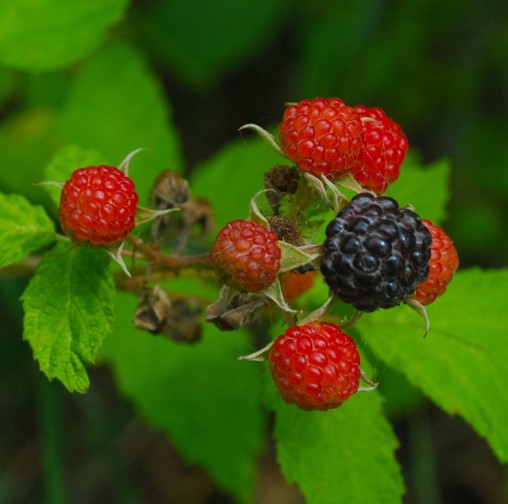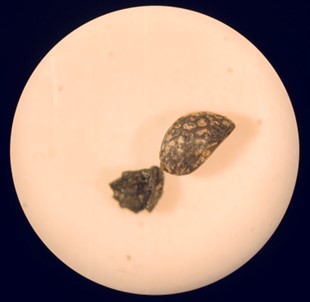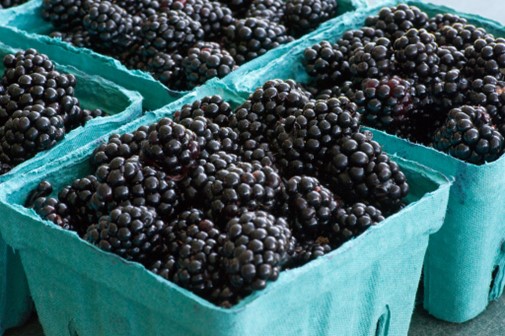With the passing of the Summer Solstice, summer is officially in full swing, which also means that blackberries are ripening for picking! June is appropriately referred to as “BlackberryMonth” within the Cherokee calendar, and thus is our June plant of the month.

Figure 1. “Common Blackberry (Rubus allegheniensis” by wackybadger (CC BY-SA 2.0).
Characteristics:
Blackberries (Rubus spp.) belong to the plant family Rosaceae, otherwise known as the “Rose Family”. Raspberry, salmonberry, and thimbleberry are also among the plants that belong to the genus “Rubus”, and raspberries and blackberries can often be confused with one another, especially before the blackberries have ripened. The difference between them is whether the receptacle (stem that attaches to the fruit) stays attached to the fruit: in raspberries, the stem is not attached, leaving a hollow space in the fruit; in blackberries, the receptacle remains attached in the center of the fruit.
Blackberries are native perennial multi-stemmed shrubs commonly found in forests, woodlands, and grassy balds. Their stems may also be referred to as canes, which grow from its root system. Like other members of the Rubus genus, blackberry stems have thorns/spines with large palmately compound leaves of three to five leaflets spread out like a hand. Stems can be viny and trailing or more erect and arching depending on the species of blackberry. When these stems become entangled, they form thickets or brambles. To prune blackberry shrubs, care must be taken not to rid the shrub of last season’s branches, as this is where the flowers and fruits appear rather than on new shoots. Flowers of white to pink color and about 1 to 1.5 inches with five petals emerge on the stems in late spring and early summer on short racemes (flower clusters).
Blackberries easily adapt to different environments, which is why they are so widespread with numerous species. They can remain dormant for several seasons, and also have durable seeds which have further contributed to their dispersal across North America by birds.
Historical Uses:
Blackberries have long been gathered and used for their edible fruits: these are eaten raw, cooked with meat into pemmican cakes, made into juice,or stored for later consumption by preserving into jams or drying. They are very good sources of Vitamin C and other nutrients. Many Native American Tribes have incorporated blackberries into their diets for thousands of years, including the Cherokees, Chippewa, Monominee, and the Meskwaki to name a few, utilizing various species of blackberries depending on geographical locations. Rubus is widely distributed worldwide with over 375 species. Figure 2 below shows the microscopic view of a Rubus spp. seed from an archaeological pit feature of a roughly 2000-year-old settlement in Cherokee, North Carolina.

Figure 2. Rubus spp. seed recovered from the Middle Woodland component of the 31JK291 “Magic Waters” site in Cherokee, North Carolina (photo by Kelly Santana).
The seeds of blackberries, raspberries, salmonberries and thimbleberries are all very similar, with a complex reticulate pattern, making it impossible to distinguish them based on the seeds alone. Fruits like blackberries would have been supplements to dietary staples, as they have a higher gathering time and must be plucked individually from the brambles, but this is a task that could have been done by all members of a household, from small children to elders. An important food for wildlife, there is also competition forforaging these fruits.
The sweet fruit is not the only useful part of the plant, however. The leaves, stems, and roots are also useful, especially as medicinal treatments. The Cherokees make a drink of a decoction of the bark of the stems for urinary tract infections, while other Tribes have used infusions for various ailments. The Menominee made infusions of the roots as a wash for sore eyes, and many other Indigenous nations have mixed the roots with the leaves to create infusions that help treat diarrhea and rheumatism. The Iroquois, for instance, have used this infusion for coughs and colds. An Abenaki herbalist, Judy Dow, removes the thorns and uses blackberry stems to weave baskets.
Blackberry Dumpling Recipe:
In this video, Nakoa Chiltoskie, a member of the Eastern Band of Cherokee Indians, demonstrates how to make the traditional Cherokee dish, Blackberry Dumplings, for the Museum of Cherokee Indian’s 2023 Spring Lecture Series, “Gathering”.

Figure 3. “Blackberries” by photofarmer (CC BY 2.0).
If you take a hike into the Great Smoky Mountains (or perhaps even just a stroll in your neighborhood), you are sure to find some blackberries along the trails this time of year. There are also many U-Pick farms local to the Knoxville area for you and yours to enjoy! Whether the berries are freshly gathered, or bought at the farmer’s market or grocery store, this blackberry dumpling recipe is a delicious summer treat to make at home.
For More Information:
- Elpel, Thomas J. 1967. Botany in a Day: The Patterns Method of Plant Identification, An Herbal Field Guide to Plant Families of North America. HOPS Press. Pony, MT.
- Moerman, Daniel E. 1998. Native American Ethnobotany. Timber Press, Portland, Oregon.
- NC State Extension Gardener Plant Toolbox. https://plants.ces.ncsu.edu/plants/allium-tricoccum/
- Salmón, Enrique 2020. Iwígara The Kinship of Plants and People: American Indian Ethnobotanical Traditions and Science. Timber Press, Portland, Oregon
- US Department of Agriculture, Natural Resources Conservation Service. 2021. PLANTS Database. Electronic document, https://plants.usda.gov/home